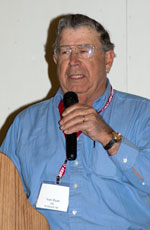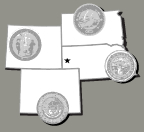Challenges for Cow-Calf Producers
by Troy Smith for Angus Productions Inc.

Political influences and economic drivers raise questions about land use in the future, said Ivan Rush.MITCHELL, Neb. (Nov. 29, 2011) — Guest speakers during the opening session of Range Beef Cow Symposium XXII discussed ways cow-calf producers can position their operations for future success. Setting the stage for following presentations, University of Nebraska Professor Emeritus Ivan Rush outlined some of the challenges to producer profitability.
Rush pointed to the continuing decline in the U.S. beef cow inventory. He said cow numbers have decreased by a half million head in the last 10 years in the four states (Nebraska, Colorado, Wyoming and South Dakota) comprising the symposium’s target area. That presents opportunity for producers still in the business, but there are fewer players actively engaged.
“Cattle prices are good,” said Rush, “but we need every bit of it to counter increased costs.”
Rush cited increased use of corn for ethanol production, creating competition for use as livestock feed. He noted the related shift of former hay and pasture acreage to corn production, which leads to higher forage costs. The value of rangeland is increasing, making it increasingly difficult to pay for by grazing cattle. Rush said political influences in addition to these economic drivers raise questions about land use in the future.
“We’re shifting to placement of heavier feeder cattle in feedlots for shorter feeding periods. Most likely, growing cattle to heavier weights (prior to placement) will take some forage away from cow herds,” said Rush. “That creates some conflict.”
Rush said the growing price spread between Choice and Select beef also raises the question of whether the industry has become somewhat complacent about quality.
The threat of increased government regulation, stemming from concern over environmental impact, animal care and animal rights, will also present challenges. Rush advised producers to be involved in influencing the decisions that will affect their businesses and their lives.
“Still,” Rush stated, “I’m convinced that, by using sound science, we can continue to produce a super product for consumers.”
The biennial Range Beef Cow Symposium was hosted Nov. 29-Dec. 1 at the Mitchell Events Center, Mitchell, Neb., by the cooperative extension and animal science departments of the University of Nebraska-Lincoln, South Dakota State University, Colorado State University and the University of Wyoming. Comprehensive coverage of the event is provided online at www.rangebeefcow.com, an event coverage site provided by Angus Productions Inc. (API), publisher of the Angus Journal and the Angus Beef Bulletin.
Editor’s Note: API's coverage of the event is made available for distribution to all media via an agreement with the Range Beef Cow Symposium Committee and API. Headquartered in Saint Joseph, Mo., API publishes the Angus Journal, the Angus Beef Bulletin, the Angus Beef Bulletin EXTRA, and the Angus e-List, as well as providing online coverage of events and topics pertinent to cattlemen through the API Virtual Library. For questions about this site, or to notifiy us of broken links, click here.

